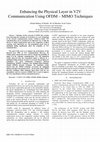Papers by Ali Al-Sherbaz
Energy efficiency of machine to machine (M2M) communications terminals is one of the major design... more Energy efficiency of machine to machine (M2M) communications terminals is one of the major design goals of M2M networks, resulting from anticipated over 50 billion M2M communications devices to be deployed into the networks by 2020 [1]. The stakeholders in the M2M communications have observed that it will be environmental and economic catastrophic to deploy M2M communications devices without solving the energy inefficiencies associated with wireless devices that are expected to be used for M2M communications. In view of the aforementioned energy challenge, sub 1GHz spectra have provided enormous opportunities that can be energy efficient, cost effective and coverage efficiency which can be utilized for M2M communications. This work will evaluate the energy efficiency benefits of optimized Sub 1GHz spectra for M2M communications.
2014 7th International Workshop on Communication Technologies for Vehicles (Nets4Cars-Fall), 2014
ABSTRACT In the recent year’s vehicular ad hoc networks VANETs has received significant attention... more ABSTRACT In the recent year’s vehicular ad hoc networks VANETs has received significant attention in the intelligent transport system research. Vehicle-to-vehicle V2V communication can be considered an important approach to help the drivers to satisfy requirements like less congestion, accident warning, road exploration, etc. The propagation issues such as path loss, multipath fading, shadowing loss, depolarization loss, and polarization mismatch loss significantly affect the reliability of V2V communication. The goal of this paper is to evaluate the performance of the PHY layer in V2V communication using a modified Spatial Channel Model SCM-MIMO. The simulation results observed that the transmitted signal is affected by a multipath fading channel.

Proceedings of The 14th Annual PostGraduate Symposium on The Convergence of Telecommunications, Networking and Broadcasting (PGNET 2013), Jun 24, 2013
"Vehicular Ad hoc network (VANET) has recently been attracting the attention of researchers as a ... more "Vehicular Ad hoc network (VANET) has recently been attracting the attention of researchers as a new technology in the wireless communication system. Vehicle-to-vehicle V2V communication can be considered an important way to help the drivers to satisfy requirements such as less congestion, accident warning, road exploration, etc. The propagation issues such as multipath fading significantly affect the reliability of V2V communication.
The goal of this work is to enhance the performance of the physical layer PHY in V2V communication. However, the cellular phone channel has been used to evaluate the possibility of apply it in the vehicular communication V2V. The simulation results observed that the transmitted signal is affected by a multipath fading channel. In order to overcome this problem two techniques are used: Orthogonal Frequency Division Multiplexing (OFDM) technique and Multiple-Input-Multiple-Output (MIMO) diversity technique. The simulation results showed that the OFDM technique overcomes the multipath fading with high transmission power. On the other hand, MIMO diversity technique called Alamouti Space-Time Code for two transmitters and two receivers (MIMO 2x2) is used to improve the error degradation with less transmission power."
Vehicular ad hoc networks VANETs has recently received significant attention in intelligent trans... more Vehicular ad hoc networks VANETs has recently received significant attention in intelligent transport systems (ITS) research. It provides the driver with information regarding traffic and road conditions which is needed to reduce accidents, which will save many people’s lives. In Vehicle-to-vehicle V2V communication the high-speed mobility of the nodes is the challenge, which significantly affects the reliability of communication. In this paper the utilising of SCM-MIMO channel model, (which is based on V-BLAST channel coding) is present to evaluate the performance of the PHY layer in V2V communication. The simulation results observed that the SCM model can overcome the propagation issues such as path loss, multipath fading and shadowing loss. The simulation considered three different environments, high, medium and low disruptions in urban traffic.

ABSTRACT When disaster strikes, optimal access to real-time information of the disaster situation... more ABSTRACT When disaster strikes, optimal access to real-time information of the disaster situation during ‘blind time’ – the time prior to the arrival of the first responders - and during response and recovery stages is essential to improve the effectiveness of the first responders and recovery. This paper describes a disaster management system, iSurvival, which uses specialist applications on the smart phones of those affected by disaster and wireless devices of first responders, to establish Wireless Mesh Networks (WMN), to facilitate the secure exchange of information in the disaster area, when the normal GSM and 3G telephone networks are compromised or unavailable. This information is further communicated with central control centre for analysis and resource scheduling for effective mobilisation of emergency services which are involved in rescue and recovery. The research, currently under the analysis and design stage, has been awarded a ‘Special Mention’ from Nokia for Ideas for Development Challenge 2012.

Mobile Multimedia/Image Processing, Security, and Applications 2009, 2009
Nowadays, Wireless and mobile communications technologies are the most important areas, which are... more Nowadays, Wireless and mobile communications technologies are the most important areas, which are rapidly expanding either in horizontal or vertical directions. WiMAX is trying to compete with WiFi in coverage and data rate, while the inexpensive WiFi still very popular in both personal and business use. Efficient bandwidth usage, Multi-Standard convergence and Wireless Mesh Networks (WMN) are the main vertical tends in the wireless world. WiMAX-WiFi convergence as an ideal technology that provides the best of both worlds: WiMAX new features and the low cost of the WiFi. In order to create a heterogeneous network environment, differences between the two technologies have been investigated and resolved. In the Multi-Carrier WiMAX-WiFi Convergence, the mismatch between the fixed WiMAX-OFDM (N fft =256) and the WiFi-OFDM (N fft =64) has been confirmed as a physical layer issue that will never be solved as MAC layer problem; therefore the current proposal is how to build what we called the "Convergence-Bridge". This bridge is like an extra thin layer, which is responsible for harmonizing the mismatch. For the WiFi-OFDM physical layer, the paper has selected the IEEE 802.11n OFDM standard while it is being developed. The proposal does not suggest changing the standard itself but modifying some functions to be configurable. The IEEE 802.11 standard has fixed the configurations for WiFi mode only, while our proposal is to set up these functions for WiFi and WiMAX modes.
Mobile Multimedia/Image Processing, Security, and Applications 2008, 2008
... Figure 2, shows that without using our proposed protocol when a malicious node (circled node ... more ... Figure 2, shows that without using our proposed protocol when a malicious node (circled node 1) attacks by falsely ... In other words it became a black hole. ... faults that could be remedied by enhancing the proposed mechanism., In this section we shall initiate such an investigation. ...

Mobile Multimedia/Image Processing, Security, and Applications 2008, 2008
Horizontal developments in communication systems have led to the emergence of new wireless techno... more Horizontal developments in communication systems have led to the emergence of new wireless technologies like WiMAX, 3G and 4G. These expansions can provide new opportunities for further advances and exciting applications in particular if we can integrate different technology standards into heterogeneous wireless networks. WiMAX and WiFi wireless networks are two examples of different standard technologies that cannot communicate with each other using existing protocols. These two standards differ in frequency, protocol and management mechanisms, and hence to construct a heterogeneous network using WiFi and WiMAX devices these differences need to be harmonised and resolved. Synchronization is the first step towards in such a process. In this paper we propose a private synchronization technique that enables WiFi and WiMAX devices to communicate with each other. Precise time synchronization in the micro second resolution range is required. The CPU clock is used as a reference for this private synchronization.
The discipline of computer forensics which has a strong multi-disciplinary background derives fro... more The discipline of computer forensics which has a strong multi-disciplinary background derives from the computing subjects in networking, programming, security and mathematics. Increasing awareness of cybersecurity and emphasising the need for a common vision among students addresses the challenges. The proposed pedagogic model is to embed the computer forensics materials within the undergraduate modules to extend students' knowledge and skills in a practical context. However, it is also recognised that the depth of ...
A heterogeneous network environment that harmoniously resolves differences between two key wirele... more A heterogeneous network environment that harmoniously resolves differences between two key wireless technologies will offer advantages in terms of cost, efficiency, and capability.
spie.org
A variety of ongoing research and development projects indicate the movement toward convergence. ... more A variety of ongoing research and development projects indicate the movement toward convergence. Intel is developing a chip that will receive and transmit both WiMAX and WiFi signals from a single die. 3 A system combining extensions of 802.11 and 802.16 has been ...
… of Microwave and …, Jan 1, 2010
The measurements of physical level parameters can become the area where decisions about cognitive... more The measurements of physical level parameters can become the area where decisions about cognitive radio will have the most striking effect. Field-programmable gate array (FPGA) enables real-time analyses of physical layer data to satisfy constraints like dynamic spectrum ...

Nowadays, Wireless and mobile communications technologies are the most important areas, which are... more Nowadays, Wireless and mobile communications technologies are the most important areas, which are rapidly expanding either in horizontal or vertical directions. WiMAX is trying to compete with WiFi in coverage and data rate, while the inexpensive WiFi still very popular in both personal and business use. Efficient bandwidth usage, Multi-Standard convergence and Wireless Mesh Networks (WMN) are the main vertical tends in the wireless world. WiMAX-WiFi convergence as an ideal technology that provides the best of both worlds: WiMAX new features and the low cost of the WiFi. In order to create a heterogeneous network environment, differences between the two technologies have been investigated and resolved. In the Multi-Carrier WiMAX-WiFi Convergence, the mismatch between the fixed WiMAX-OFDM (N fft =256) and the WiFi-OFDM (N fft =64) has been confirmed as a physical layer issue that will never be solved as MAC layer problem; therefore the current proposal is how to build what we called the "Convergence-Bridge". This bridge is like an extra thin layer, which is responsible for harmonizing the mismatch. For the WiFi-OFDM physical layer, the paper has selected the IEEE 802.11n OFDM standard while it is being developed. The proposal does not suggest changing the standard itself but modifying some functions to be configurable. The IEEE 802.11 standard has fixed the configurations for WiFi mode only, while our proposal is to set up these functions for WiFi and WiMAX modes.

Horizontal developments in communication systems have led to the emergence of new wireless techno... more Horizontal developments in communication systems have led to the emergence of new wireless technologies like WiMAX, 3G and 4G. These expansions can provide new opportunities for further advances and exciting applications in particular if we can integrate different technology standards into heterogeneous wireless networks. WiMAX and WiFi wireless networks are two examples of different standard technologies that cannot communicate with each other using existing protocols. These two standards differ in frequency, protocol and management mechanisms, and hence to construct a heterogeneous network using WiFi and WiMAX devices these differences need to be harmonised and resolved. Synchronization is the first step towards in such a process. In this paper we propose a private synchronization technique that enables WiFi and WiMAX devices to communicate with each other. Precise time synchronization in the micro second resolution range is required. The CPU clock is used as a reference for this private synchronization.
Cambridge Univ Press
Synthesis of hexagonal planar array using swarm-based optimization algorithms Anirban Chatterjee ... more Synthesis of hexagonal planar array using swarm-based optimization algorithms Anirban Chatterjee and Debasis Mandal Design of non-uniform concentric circular antenna arrays with optimal sidelobe level reduction using biogeography-based optimization Nihad Dib and Ashraf Sharaqa High isolation and compact MIMO antenna system with defected shorting wall
Conference Presentations by Ali Al-Sherbaz

Software Defined Network (SDN) provides a new fine-grained interface enables the routing algorith... more Software Defined Network (SDN) provides a new fine-grained interface enables the routing algorithm to have a global view of the network throughputs, connectivity and flows at the data-path. This paper aims to provide a novel approach for dynamic routing algorithm for Software Defined Network in Wide Area Network (SDN-WAN); based on using a modified shortest-widest path algorithm with a fine-grained statistical method from the OpenFlow interface, called Shortest-Feasible OpenFlow Path (SFOP). This algorithm is designed to identify the optimal route from source to destination, providing efficient utilization of the SDN-WAN resources. It achieves this aim by considering both the flow requirements and the current state of the network. SFOP computes the optimal path which provides the feasible bandwidth with the lowest hop count (delay). That will present better stability in SDN communication, QoS, and usage of available resources. Moreover, this algorithm will be the base for an SDN controller because it extracts the widest available bandwidth from source to destination for a single path. It enables the controller to decide whether it is enough to use this simple algorithm only, or if a more complicated algorithm that provides larger bandwidth such as multiple-path algorithms is needed. Finally, a testbed has been implemented using MATLAB Simulator, Pox controller, and Mininet emulator will be discussed. The latency comparison of SFOP algorithm with three other algorithm’s latencies shows that this algorithm finds better latency for an optimal path. Evidence will be shown that demonstrates that SFOP has good stability in dynamic changes of SDN-WAN.











Uploads
Papers by Ali Al-Sherbaz
The goal of this work is to enhance the performance of the physical layer PHY in V2V communication. However, the cellular phone channel has been used to evaluate the possibility of apply it in the vehicular communication V2V. The simulation results observed that the transmitted signal is affected by a multipath fading channel. In order to overcome this problem two techniques are used: Orthogonal Frequency Division Multiplexing (OFDM) technique and Multiple-Input-Multiple-Output (MIMO) diversity technique. The simulation results showed that the OFDM technique overcomes the multipath fading with high transmission power. On the other hand, MIMO diversity technique called Alamouti Space-Time Code for two transmitters and two receivers (MIMO 2x2) is used to improve the error degradation with less transmission power."
Conference Presentations by Ali Al-Sherbaz
The goal of this work is to enhance the performance of the physical layer PHY in V2V communication. However, the cellular phone channel has been used to evaluate the possibility of apply it in the vehicular communication V2V. The simulation results observed that the transmitted signal is affected by a multipath fading channel. In order to overcome this problem two techniques are used: Orthogonal Frequency Division Multiplexing (OFDM) technique and Multiple-Input-Multiple-Output (MIMO) diversity technique. The simulation results showed that the OFDM technique overcomes the multipath fading with high transmission power. On the other hand, MIMO diversity technique called Alamouti Space-Time Code for two transmitters and two receivers (MIMO 2x2) is used to improve the error degradation with less transmission power."